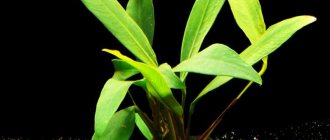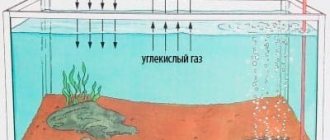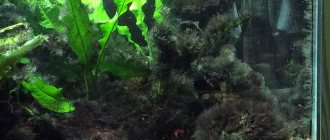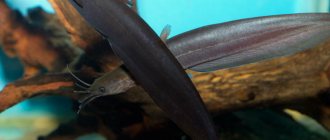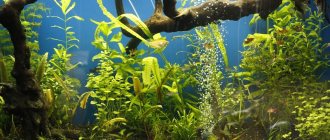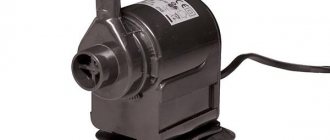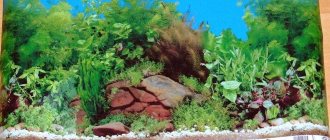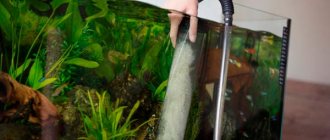Description
Vallisneria is a perennial herbaceous plant. In nature, it is found in subtropical and tropical climates, in various fresh water bodies. There are also varieties that have taken root in temperate climates. The current does not matter for this type of underwater flora, so it can be seen in lakes, rivers, ponds, etc.
It is easy to visually distinguish Vallisneria, as it has an original appearance. The bushes consist of long, rich green leaves that stretch upward to the very surface, where they then lie along the water column. This plant is characterized by rapid growth, and in bright, intense light it can stretch to the surface in an aquarium in just a week.
The roots grow up to 7-10 cm, and the leaves in nature can stretch from 50 cm to 2 m. Vallisneria is capable of blooming, but the flowers are small in size and not particularly attractive, so aquarists do not attach importance to this process.
Maintenance and care
Vallisneria is an unpretentious aquarium plant. This is an excellent option for those who have just purchased an aquarium and are starting to get acquainted with the underwater flora. The bushes quickly grow and send out lateral shoots, from which young shoots quite soon reach the size of the mother bush. Therefore, the main task of the aquarist is to limit growth by trimming the leaves themselves and thinning out new shoots.
In general, there is no need to create special conditions for growing Vallisneria. As a rule, the following is enough for her:
Soil . A small layer of 3-4 cm is also suitable. The best option is sand or gravel with a fraction of 4-6 mm. The composition of the substrate itself does not matter, so there is no need to apply fertilizers at the root. There is enough waste generated as a result of the life activity of the inhabitants of the aquarium;
Recharge . Although Vallisneria is unpretentious, it can begin to die if it lacks nutrients. Therefore, if the leaves begin to rot, then you need to apply fertilizer in the form of paste or tablets. Liquid macronutrients are also suitable;
Water parameters . The optimal temperature is 20-25 degrees, but fluctuations beyond these values are also acceptable, but if the water is only 15°, the plant’s growth stops and it soon dies. In addition, acidity should be 5-7 units, hardness - no more than 8°;
Light . Daylight hours should be about 12 hours, since Vallisneria is still a tropical plant, and therefore it is accustomed to a lot of light.
Vallisneria needs to be trimmed regularly, but you should not shorten the leaves themselves, but cut off the entire rosette, leaving only the young one. You also need to remember that there should be no iron in the water, otherwise the bushes will collapse very quickly.
We recommend visiting the section: Unpretentious aquarium plants
Vallisneria spiralis: maintenance and breeding
Photo: Vallisneria spiralis
Photo: Vallisneria spiralis
Distributed in both tropical and subtropical regions of the entire globe. It is found in the water bodies of Central Asia. This plant is the most widespread among aquarists. Its long, ribbon-shaped, bright green leaves are corkscrew-curled and form dense thickets that reach the surface of even relatively deep aquariums. Under favorable conditions, the leaves can be 70-80 cm long, but usually they are somewhat shorter - up to 40-50 cm. Vallisneria is usually placed in the background and at the side walls of the aquarium. Due to the fact that this plant is unpretentious and reproduces very quickly, it is especially popular among beginner aquarists. You can grow it in an aquarium throughout the year. Tropical and moderately warm aquariums with water temperatures are suitable for Vallisneria. 20-28 °C. In colder water, its growth slows down quite noticeably. Vallisneria requires soft water. If the hardness is more than 8°, the plant feels unsatisfactory: growth deteriorates and the size of the leaves decreases. The active reaction of water must be neutral or slightly acidic. The pH value can fluctuate between 5-7. It is advisable to regularly change the water, but the plant can survive well in old water that has not been replaced for a long time. Vallisneria is undemanding in terms of lighting. The light can be moderate or bright. If it is deficient, the plant becomes stretched and the color of the leaves becomes yellowish. Natural light is very useful for him. Any lamps, both fluorescent and incandescent, can be used as sources of artificial light. The power of the illuminator is selected individually depending on the plants surrounding Vallisneria. Daylight hours can vary quite widely, from 8 to 16 hours. The soil should be nutritious and well silted. Usually, natural siltation of the soil is sufficient for satisfactory development of Vallisneria. When planting in new soil, additional fertilizing may not be necessary. The root system of Vallisneria is very delicate, so a substrate consisting of relatively small fractions is most suitable for it. It is best to use coarse river sand. The thickness of the soil layer can be small, 3, maximum 4 cm is quite enough. If the soil is well silted, mineral fertilizing of Vallisneria is not needed
It is very important to ensure that ferric salts and iron oxide (rust) do not get into the aquarium. This is very important to know for aquarists who use aquariums whose frame is made of an ordinary iron corner
When rust gets into an aquarium, the plant dies very quickly. Under favorable conditions, Vallisneria easily reproduces, forming many shoots on which daughter plants appear in turn. Over the course of a year, one specimen produces several dozen and even hundreds of daughter plants. They can be separated from the mother immediately after the formation of 2-3 leaves and the appearance of roots. Flowering of Vallisneria can be observed very often, but it does not form seeds, since its flowers are unisexual (there are male and female specimens). In the aquariums of our hobbyists, only female plants can be found, so seed propagation in artificial conditions practically does not happen.
Reproduction and planting in the ground
This process is not particularly complicated and even a novice aquarist can handle it. Reproduction occurs vegetatively or through seeds. Of course, the first option is more popular. The uterine bush sends out a tendril to the side, on which the rudiment of a rosette is formed. As soon as it comes into contact with the ground, it begins to consolidate and send out roots, forming a baby. During the year, the number of shoots can be about 100 units.
Also, some aquarists prefer to propagate Vallisneria through seeds. But to do this, you need to plant a male and female plant next to each other. When flowering occurs, small seeds appear on the female bush. They sink to the bottom. After which they germinate. However, this method is almost never practiced, since a lot of shoots are formed from one mother bush, which then causes difficulties with thinning.
As for landing, there is nothing complicated here. You need to dig a small hole, place a rosette there, with its roots in the ground, and leave the rest on the surface of the substrate. It is important not to overwhelm the growth point.
Reproduction
Vallisneria reproduces vegetatively or by seed. Seed propagation at home is difficult. Since the plants are bisexual, it is necessary to plant male and female specimens side by side for pollination. In aquariums, most female specimens are found. The flowering time must also coincide. Some time after pollination, seed pods form on the female plant, which then fall into the water.
The image shows a flowering Vallisneria with a “baby” (on the ground), which can be detached and planted as an independent bush.
In an aquarium, it is best to propagate plants vegetatively. Up to 50-60 children are formed on the mother plant per year. When 3-4 leaves form on the daughter plant and roots develop, carefully separate the baby and plant it in the ground.
Why doesn't Vallisneria grow?
It is difficult to answer this question unambiguously. In many ways, everything depends on the attentiveness of the aquarist himself and the conditions that he created. There are different reasons. For example this:
- Temperature too low;
- Short daylight hours or low light intensity;
- Next to Vallisneria there are other plants whose roots “press” on it (for example, this problem often arises if Cryptocoryne is located nearby);
- The water contains insufficient nutrients. In this case, you need to test the water for nitrates and phosphates, and then decide whether to apply fertilizers or adjust the frequency of changes;
- There are unwanted chemical compounds or trace elements in the water. As already mentioned, Vallisneria does not tolerate iron. She may also react negatively to algae medications.
Spiral
One of the most popular and beautiful species. Visually similar to Vallisneria vulgaris. But its peculiarity is that all the leaves curl into a spiral, which is why the bush looks especially attractive. This is the first Vallisneria discovered by man. Twisting is typical for female bushes. In nature, the plant reaches 80 cm in length, the leaf width is no more than 1.2 cm. Reproduction occurs vegetatively or through seeds. Flowers ripen, emerge, and then pollination occurs through direct contact;
Tiger
Has light green leaves. It is considered medium in size, as it stretches up to 1 m. It has variegated colors, namely small dots and strokes of a darker shade. Because of this, the leaf slightly resembles a tiger skin. This is where the name came from;
Types and varieties of Vallisneria
Vallisneria Spiral - this variety of Vallisneria was one of the first to be discovered and got its name due to the ability of its peduncles to twist in the form of a spiral. The culture is a rosette consisting of linear leaf plates reaching a length of up to 80 centimeters. The edges of the leaf blades are finely serrated. The inflorescences are small. Before flowering, the peduncle floats to the surface, where pollination occurs, after which it again goes under water. The flowering time of the crop is mid-summer.
Vallisneria Americana - the plant consists of a mop of small, ribbon-shaped, long and soft leaf plates of light green color with a reddish tint. The height of the crop can reach up to 100 centimeters. At home it rarely blooms; in the wild the plant blooms in mid-summer.
Vallisneria gigantea - the height of the leaf plates can reach up to 2 meters and the width up to 4 centimeters. The leaves are dark green, growing in tufts with serrated edges. This algae can be used for large and tall aquariums and artificial ponds.
Vallisneria Nathans is an aquatic plant reaching a length of up to 100 centimeters. It can be grown in aquariums and artificial ponds. The crop has an underdeveloped, creeping root system and narrow, light green leaf blades with serrated edges. When grown in an aquarium it does not bloom; in a pond it blooms in mid-summer.
From the editor: Fluorescent glofish fish
Vallisneria tigris
This variety of culture can reach a length of up to 1 meter. The leaf blades have a light green tint with small transverse stripes and black dots. Thanks to its decorative variegated colors, the plant received its name “Vallisneria tiger”.
Vallisneria torsionum - in the wild, this plant species grows in Vietnam, Central Asia and Japan. The culture has dark green leaf blades, the length of which is about 40 centimeters. They have a spiral shape and edges with frequent serrations. The growing season of Vallisneria lasts throughout the year. When grown in an aquarium, it rarely blooms and does not produce seeds.
Vallisneria Asiatica - the culture reaches 50 centimeters in length, and the diameter of the algae is up to 10 centimeters. It has fragile, spiral-shaped leaf plates of bright green color and a powerful root system. The plant requires good lighting for normal development.
Vallisneria vulgaris is the most common aquarium culture. It has long, bright green, ribbon-shaped leaf blades twisted in a spiral. The height of the crop reaches up to 80 centimeters. The plant has several varieties, differing from each other in height, shade of leaves and degree of curl. The root system is strong, thin and long, milky yellow in color.
Vallisneria Leopard
It has long, straight, bright green leaves reaching a height of up to 70 centimeters. While the leaf mass is young, it has a green tint, but as soon as the plant is a little over a year old, streaks of brownish color, reminiscent of leopard spotting, begin to appear on the leaves. In aquarium conditions, the culture does not bloom or bear fruit.
Vallisneria dwarf is a dwarf variety with thin dark green leaf blades reaching a length of up to 50 centimeters. The measles system is thin, flexible, durable. The plant loves light very much, so it should be planted in the center of the aquarium so that other algae do not shade it.
Vallisneria floating - the plant reaches a height of up to 70 centimeters and has narrow, ribbon-shaped leaf plates of a bright green hue. The algae has no stem; the leaves grow from the roots. Reproduction occurs by lateral shoots.
Vallisneria Red - the culture has a compact, creeping root system and linear leaf blades with finely serrated edges, reaching a height of up to 1 meter. The color of the leaf blades depends on the light intensity and can be either green or light green near the roots and red-brown at the ends. When domesticated, the plant does not bloom.
Gigantic
The name speaks for itself. The largest species of Vallisneria. In reservoirs it reaches a height of up to 2 meters, the leaf width is about 4 cm. This plant is planted at the back wall or even in the corner, where it grows in a short time, forming a whole “curtain” of long dark green leaves;
Kinds
Spiral
The plant owes its name to the Italian botanist Antonio Vallisneri. And its species Vallisneria spiralis is so named not for the shape of its leaves, but for a feature that was noticed by the naturalist Linnaeus. Vallisneria spiralis has a spiral, which appears due to the peduncle of the female flower, which coils after pollination. Vallisneria spiralis is considered the most common type of plant; it has corkscrew-shaped or linear leaves of a bright green hue up to 20 cm long. In the most favorable conditions, spiral Vallisneria grows up to 80 cm.
Vallisneria spiralis is a very useful plant, as it effectively releases large amounts of oxygen, which is so necessary for many aquarium inhabitants.
Vallisneria spiralis can grow in an aquarium all year round and multiplies quickly. Spiral Vallisneria looks ideal on the side and back walls of the aquarium, planted in small groups, which turns its walls into an advantageous green background for all its inhabitants.
Tiger
Tiger Vallisneria is a subspecies of the spiral species and is distinguished by the presence of dark strokes on the leaves that resemble tiger stripes. Its leaves will brightly decorate the aquarium if the plant is planted on the sides, as an excellent background for decorative fish. Tiger vallisneria can grow up to 1 meter and form picturesque thickets of elongated green leaves.
Gigantic
Vallisneria gigantea has attractive dark green leaves. In size, this plant can reach almost 2 meters in length and 4 cm in width and is well suited for the front corner of a large aquarium. Its bushes can become an excellent refuge for small fish species. Vallisneria gigantea is rarely grown in home aquariums due to its impressive size.
Nathans
Vallisneria natans is a variety of American plant species. This species has long, thin and narrow leaves, growing up to 100 cm in length, and is usually planted along the side and back walls of the aquarium. The plant is able to grow quickly in diffused light and does not shade other plants growing in the lower part of the container. Vallisneria natans also does a good job of participating in the metabolic process and saturating water with oxygen.
Nana
Vallisneria nana or dwarf has a miniature appearance. Its thin dark green leaves stretch towards the surface of the water, not even providing shade. In natural conditions, the plant reaches up to 70 cm, and in aquariums it does not exceed 30-50 cm. Considering the size of the aquarium, Vallisneria nana is planted in small bushes on the middle ground of the tank.
Twisted-leaved
Vallisneria torsionum has beautiful and strongly serrated or helical leaves, reaching up to 40 cm in length and 8 mm in width. This species is best planted in the background of the aquarium or on the sides.
Return to content
American
It is a large bush with ribbon-shaped leaves. They have low rigidity and serrated edges. They have a basic green color, but there is a reddish tint. The width is standard, 1-2.5 cm, the length varies from 80 to 100 cm. This variety is also called “aquarium wallpaper” because they are planted at the back wall, and soon they form a continuous wall of green thickets. Today there are several varieties of American Vallisneria on the market, but the “twisted-leaved” one is especially valued, since its leaves are 5 cm wide, and from the very base they curl, forming very beautiful thickets;
Appearance
Vallisneria is native to Northern Australia. This plant belongs to the perennial category. It has a short and poorly developed rhizome, the length of which does not exceed 10 cm. It is characterized by the presence of narrow, long and smooth leaves, reminiscent of variegated ribbons in their appearance.
It is recommended to plant the plant near the back walls. The leaf blades are distinguished by a rich emerald green color, but in some cases they can change their color to reddish or brown shades.
Despite the fact that Vallisneria belongs to the category of flowering plants, its inflorescences do not have decorative value, since they are small and not very attractive. The plant reproduces mainly by vegetative means, as well as with the help of lateral shoots.
There are a number of varieties of Vallisneria, each of which has its own special features regarding both appearance and conditions of detention.
Gigantic
A large plant whose leaf height can exceed 2 m. The plant has a rich green color and creates natural shading. This variety of Vallisneria is suitable for large aquariums, and it is recommended to plant it in the corners near the rear walls of the vessel.
The plant adapts well to different types of soil and changes in temperature conditions. But for full growth and development, it needs bright lighting for at least 12 hours a day. The best habitat for giant vallisneria is soft, slightly acidified water.
American
A very beautiful and spectacular plant with soft ribbon-like leaf plates. It can reach a height of 90-100 cm. The leaves have a double color, which is a combination of green and reddish shades. The American twisted-leaved Vallisneria is especially impressive for aquarium decoration, the leaves of which form a beautiful twisted spiral.
To create optimal conditions, the plant requires additional side lighting. Its small size allows this variety of Vallisneria to be used to decorate both the foreground and background of an aquarium.
Spiral
This subspecies is especially loved by aquarists for the ability of the peduncle to curl into a spiral, which looks very beautiful in an aquatic environment. The size of spiral vallisneria is relatively small - no more than 80 cm. The plant needs bright natural light. The optimal daylight hours are approximately 15 hours a day.
In winter, additional lighting is required, because otherwise the leaf blades of spiral Vallisneria lose their beauty, turn pale, thin out, and acquire an unhealthy yellowish color.
Nana
This variety of Vallisneria differs from others in its particularly thin leaf plates of a dark green color, reminiscent of hairs in appearance. A characteristic feature of Vallisneria nana is also its compactness, because the height of the foliage does not exceed 35 cm.
Thanks to this feature, the plant can be used to decorate even small aquariums and planted in the foreground. The optimal environment for growing this variety is clay soil. The plant also needs additional moderate lighting.
Tiger
This crop has a characteristic variegated coloring, which has a clear resemblance to a tiger skin, in honor of which the plant deserves its name. This variety is compact, small in size, and unpretentious in terms of care, which is why tiger vallisneria has gained immense popularity among aquarists. Most often, the plant is planted on the sides of the container in order to create a spectacular background for decorative fish.
Neotropicalis
A beautiful aquarium plant with straight leaves. The leaves of Vallisneria neotropicalis can have different colors, which, depending on the conditions of detention, vary from green to brown and red shades. A large subspecies that is suitable for growing and decorating only in large aquariums.
Nathans
One of the most popular varieties of American Vallisneria. This plant is characterized by thin and narrow leaf blades of a bright green color, the length of which can reach 100 cm.
Aquarists prefer to plant Nathans near the back and side walls for decorative purposes. This culture is valued by users for its increased ability to saturate water with oxygen and normalize metabolic processes.
